There’s only a couple of weeks to go until the British asparagus season kicks-off officially but I can’t hold back any longer on forcing a little bit of Spring into the kitchen whether it wants to be there or not. I’ve been getting a head-start on thinking about all the wonderful ways to enjoy asparagus – it’s a small but determined act of rebellion against the doggedly cold days and evenings we’ve endured for too long. For the truly-impatient there’s some forced asparagus in the supermarkets that you could do dress rehearsals with until the A-list stars of the season are ready for their close-up.
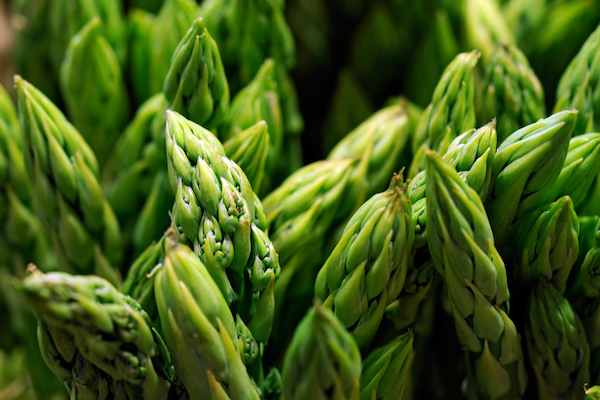
Cooking it
Asparagus stalks need to be trimmed to get rid of the really woody parts which defy any attempts to make them tender or tasty. Peeling or scraping the stalks is only worthwhile if they’re quite thick and / or it’s getting towards the end of the season when things tend to toughen up a little. Even then, only go as high as a couple of inches below the tasty tips.
Steaming – as opposed to boiling – does its best to retain as much as possible of the asparagus’ flavour but still can’t get around the inherent problem that the fine tips cook at a different rate to the thicker stalks. 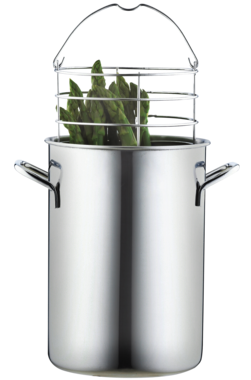 You don’t want to end up with perfectly tender stalks but limp and soggy tips; nor suffer the other extreme and find that the stalks are tough and rather like nibbling on a bit of tree trunk. Get round it by tying together handful bundles of asparagus stalks – already washed, trimmed and peeled as necessary. Stand them up in a tall pot of boiling water so that that the stems are immersed in the water but the tips aren’t. Pop the lid on and hey presto, the tougher stalks get a rapid boiling treatment and the tips get a more delicate steaming. How long you need to leave it depends on the size of your asparagus. Test after ten minutes. Thin spears or just the tips can be more straightforwardly steamed / boiled.
You don’t want to end up with perfectly tender stalks but limp and soggy tips; nor suffer the other extreme and find that the stalks are tough and rather like nibbling on a bit of tree trunk. Get round it by tying together handful bundles of asparagus stalks – already washed, trimmed and peeled as necessary. Stand them up in a tall pot of boiling water so that that the stems are immersed in the water but the tips aren’t. Pop the lid on and hey presto, the tougher stalks get a rapid boiling treatment and the tips get a more delicate steaming. How long you need to leave it depends on the size of your asparagus. Test after ten minutes. Thin spears or just the tips can be more straightforwardly steamed / boiled.
What you’re aiming for is spears which are tender to the point of a knife and holding their shape well. If you intend to serve the asparagus cold then be sure to rinse them in very cold water as soon as they’re cooked to prevent them cooking any more.
Allow a handful of spears per person.
Eating it
Here are my top ten classic ways (most definitely not in any order of preference) of enjoying cooked asparagus as great snacks, starters or lunches. I’m sure you can work out which is most suited to when. Almost all of them have little or no need for eating utensils – asparagus tastes even better when you eat it with your fingers.
1. Dipped in melted butter and served with toast. Ideally clarify the butter by melting it over a very low heat, letting it stand off the heat for a couple of minutes and then running it through a muslin sieve. Old recipe books say to dip the toast in the water that the asparagus boiled/steamed in but I’m not so sure about that.
2. Use very thin asparagus or just the tips as garnish for eggs ‘en cocotte’ (baked in little pots). For each person: butter a ramekin and break an egg into it. Season and put a knob of butter on top of the yolk. The ramekin sits in a baking tin with boiling water poured into the tin until it goes halfway up the outside of the ramekin. Bake at 180C for approx 12-16 minutes until the eggs is set. Wipe the ramekin dry and serve with steamed asparagus tips arranged across the top. A common variation is to add two tbsps of creme fraiche – one underneath and one on top of the egg. Dill is good too.
3. This one makes a nice accompaniment to chicken or fish. For each handful of asparagus cook a large tablespoon of flaked almonds in a big piece of butter for a couple of minutes, add a squeeze of lemon, some salt and pour over the cooked spears.
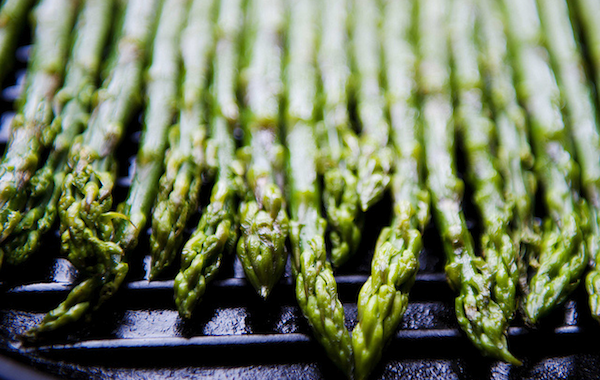
4. I like to griddle asparagus when it’s headed for a salad – the charredness gives terrific colour and flavour. For each handful of (uncooked) asparagus roll the spears in a combo of 2tbsps extra virgin olive oil, 1tbsp lemon juice, salt, pepper and 2tsps chopped mint leaves. Get the griddle mad hot and cook the spears for 7-10 minutes until charred and tender. You could griddle pre-cooked asparagus for a shorter time. These spears go well in a mackerel, beetroot and goats cheese salad.
5. Griddling again, but this time wrap three spears in thin slice(s) of prosciutto or jamón as soon as they emerge from the griddle. The heat from the asparagus will get the meat’s juices going too. A very tasty tapas.
You see what I mean. We’re only half-way and there are so many mouth-watering asparagus possibilities, so little time in its season. In its prime asparagus has a unique delicacy and complexity of flavours. When it’s British, even more so. If cooked well and served in a way that creates a perfect platter for its flavours to rest upon then you’re onto a winner. Add in the sunshine and warmer evenings that asparagus usually heralds and its annual furore makes a lot of sense.
Conversely, when all those things are ignored this vegetable can be the work of the devil. The memory is sadly unshiftable of soggy, tinned asparagus interred in omelette and served up as a B&B breakfast on one of those grey November days that Scotland specialises in. That’s number one in my ways not to cook asparagus.
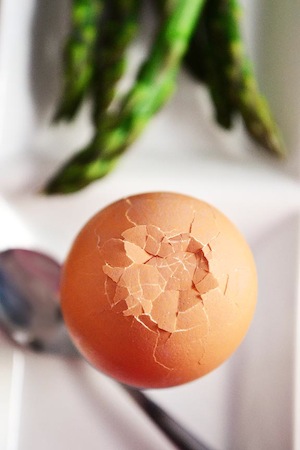 Ok, breather over – next five:
Ok, breather over – next five:
6. Cook the asparagus and then lay the spears in a buttered shallow ovenproof dish with the layers top-to-tail so that you don’t have all the spears facing the same way. Sprinkle grated parmesan amongst them as you go. Put a few knobs of butter on top and then grill for a couple of minutes.
7. As a healthy soldier to dunk into a soft-boiled egg.
8. Cold asparagus and mayonnaise. Be sure to start off with all the ingredients at room temperature. Whisk 3 egg yolks in a bowl with some salt, pepper, and a tsp of lemon juice or white wine vinegar. Once all that is smooth slowly add in 450ml olive oil. Start off drop-by-drop and build up from there – being too hasty with the oil can be a cause of curdling. The mayo becomes thick and billowy. Test for seasoning and add more lemon if you fancy. At the very end, add a tbsp of boiling water to help it hold. That should be ample mayonnaise for four.
9. Warm asparagus and hollandaise. You see how I saved the best for last? This pairing is so good and so classic that it is both 9 and 10. Basic yet divine hollandaise for four people: Sit a heatproof bowl over a pan of simmering water. 5 egg yolks and 5 tbsps water go into the bowl. Whisk well to get a bit of body into it and continue whisking as you gradually add 550g of butter that has been cut into cubes. Keep going with the whisk until it’s thick and creamy. You will need a little salt and a few squeezes of lemon to finish it off. Serve straight away in a bowl alongside freshly cooked asparagus and dip away.
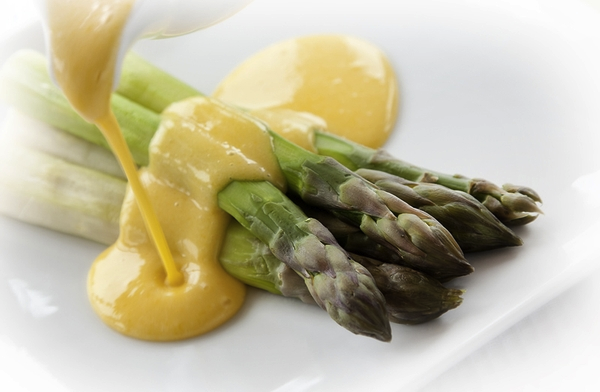
10. Last but by no means least are a few ways to enhance hollandaise. I would say ‘improve’ but I’m not sure that classic hollandaise is improvable. Fold-in the extras after the hollandaise is done and in stages so that you can gauge when enough is enough for you. Sauce Maltaise: add the zest and juice of a blood orange. Sauce Mousseline: add 3tbsps whipped cream.
Roll on the green spears of Spring.




1 Comment
I am longing for my asparagus bed to start showing a few spears….. nothing at all yet, i know i am impatient but those first few spears are such a treat…